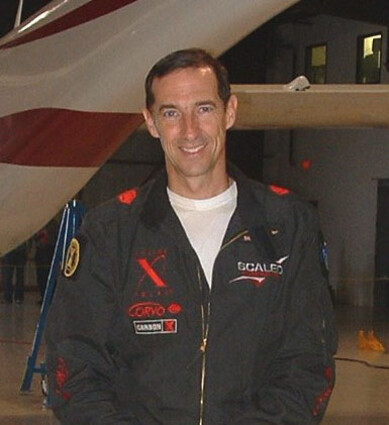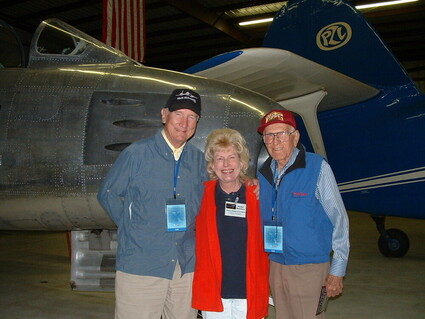Aerospace icons at Mojave Air & Space Port – the day I met Louis Zamperini
Short Flights
November 25, 2023
It's hard to believe that it has been 19 years since Brian Binnie flew for the Ansari X-Prize with SpaceShipOne on Oct. 4, 2004 with Scaled Composites Model 316. Designed by Burt Rutan and funded by Paul G. Allen.
He also flew the first powered flight of SS1 on Dec. 17, 2003, the 100th anniversary of the Wright Brothers flight at Kill Devil Hills.
On Dec. 16, Plane Crazy Saturday will have a special 20th anniversary presentation by Chuck Coleman about that flight at 11 a.m. in the Mojave Air & Space Port Board Room. Limited seating, so come early!
William Brian Binnie was born on April 26, 1953 in Indiana, but soon his family moved to Scotland when Brian was five. His father was Scottish and a professor of physics at Purdue University. He took a position at Aberdeen University in Scotland and the family lived in Scotland until Brian was a teenager.
What a diverse and interesting life he led. His education was impressive. He earned a B.S. in Aerospace Engineering and an M.S. in Fluid Mechanics and Thermodynamics from Brown University as well and an M.S. in Aeronautical Engineering from Princeton University. He is a graduate of the U.S. Navy's Test Pilot School, Patuxent River, MD; Naval Aviation Safety School at Monterey, California and the Defense System Management College at Fort Belvoir, Virginia.
Our good and dear accomplished friend passed away on Sept. 15, 2022. He will be forever in our hearts.
The photo in this article shows Bob Gilliland, famous Lockheed SR-71 test pilot and Louis S. Zamperini, Olympian and World War II hero, with me in front of my husband's F-86 Sabre, before Brian's record-setting flight Oct. 4, 2004. We had a breakfast at the Hansen Hangar for special friends before the historic flight!
I had never met Zamperini before and was absolutely spellbound when I heard the incredible story of his life. He was born in New York on Jan. 26, 1917 and his family moved to Torrance, California in the 1920s. He attended Torrance High School and joined the track team, winning every event he entered.
In his junior year, 1934, his 4-minute, 21.2-second time for running a mile set a world Interscholastic record that stood for 20 years and won him a scholarship to USC where, at 19, he promptly qualified for the 1936 U.S. Olympic team as its youngest member. He was a devoted supporter of USC and often wore a hat sporting his devotion.
The Olympics were held in Berlin and Zamperini impressed Hitler with his spectacular final lap time of 57 seconds in the 5,000-meter event. Hitler commanded a personal audience with "the American boy with the fast finish."
Unbelievably, Zamperini stole a Nazi flag off of the Reich's Chancellery and was caught by the Gestapo, talked his way out of the deed and was able to bring the flag home.
After returning to USC, he continued to set records that were unchallenged for over 15 years. As World War II loomed, Zamperini joined the Army Air Corps, enlisting at Fort MacArthur in California in September 1941.
He entered training in Texas as a bombardier in January of 1942 and was commissioned a second lieutenant in August 1942. He was deployed to Hawaii in October 1942 with the 307th Bombardment Group, 7th Air Force.
His B-24 "Green Hornet" was called out to search for a B-25 that was shot down near Palmyra Island in May 1943. In the dark wee hours, both engines on the left side failed simultaneously and they hit the ocean creating a huge explosion. Only three crewmembers of 10 survived the ditching at sea; the pilot, the tail-gunner and Zamperini.
He pulled his fellow crewmembers onto an inflatable raft and for 47 days they drifted 2,000 miles on the ocean. There were six candy bars, two small fish, a small shark and two raw birds to eat. The only water available was sporadic rainfall.
The tail-gunner, Francis MacNamara died while they desperately tried to survive in the life raft. On the 47th day a small Japanese harbor boat picked up Zamperini and pilot Russell Phillips in the Marshall Islands. They were moved from Kwajalein to Truk and eventually to Japan as POWs.
At Yokohama, and for the remainder of the war, Lou was shifted from camp to camp, beaten by a sadistic, officer-hating Sgt. Watanabe, known as "The Bird." They knew that he was a great track star and broke his legs so he could not run again.
After Japan surrendered, it took Zamperini over a month to reach home because he had to stop several times to rest and recuperate. His normal weight was 165 pounds and he had dropped to 79 pounds. His parents had been informed two years earlier by President Roosevelt that he was killed in action.
He finally flew into Long Beach on Oct. 5, 1945, was promoted to Captain and awarded the Air Medal with three oak leaf clusters, a Purple Heart with cluster and Philippine's Liberation, Asiatic and Pacific and American Theater ribbons with battle stars.
One day Billy Graham came to town and Zamperini attended his services and recalled the thousands of promises he had made while floating in the life raft. He dedicated the remainder of his life to Christian work, a vow that he has upheld until his death on July 2, 2014. He was 97.
He returned to Japan to forgive his guards, even the worst tormentor, but "The Bird" was nowhere to be found.
Torrance Airport was renamed Zamperini Field on Dec. 7, 1946 to honor him and his story was published in a book, "The Devil at My Heels," by Zamperini and David Rensin. This book is great story of brutality of war, the tenacity of the human spirit, and the power of God's love and forgiveness.






